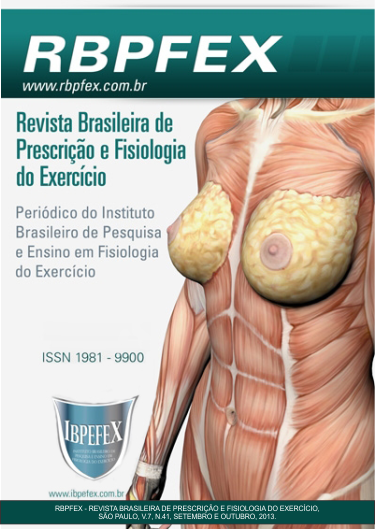Hypotensive response after swimming practices in paused or long training
Abstract
The physical exertion of swimming is an important factor in reducing blood pressure, showing an effect of hypotension after the session, an important factor for normotensive, hypertensive and even pre hypertensives, one aspect of acting as a non-pharmacological aid and even, beyond to prevent other cardiac diseases. The objective of this study is to compare the post-exercise hypotension in normotensive adolescents during interval and continuo trainning. Methods: 15 normotensive female and male underwent two experimental sessions on different days, the first session was 30 minutes of continuous swimming and the second session were 5 shots 50m intervals of 5min. BP was measured at rest pre-exercise period and and 1 in 1 hour after exercise recovery. Results: A repeated measures ANOVA showed significant reduction after 60 min of measuring post training in both sessions. No significant interaction between time of measurement and exercise in DBP was observed. For SBP, higher values at the start of the interval trainning, consequently there was a more pronounced fall in blood pressure. Conclusion: According to our sample, the swimming exercise with continuous and interval training was effective in reducing blood pressure during the first 60 minutes, after these values remained standard, however there was a decrease in heart rate during the 3 hours evaluated.
References
-ACSM, American College of Sports Medicine. Manual de pesquisa das diretrizes do ACSM para os testes de esforço e sua prescrição. Rio de Janeiro; RJ. Guanabara. 2010.
-Chobanian, A.V.; Bakris, C. l.; Black, H.R.; Cushem, W.C.; Green, L.A.; Izzo, Jl.Jr.; Jones, D.W.; Materson, B.J.; Oparil, S.; Wright, Jr. Roccela, E. J. National High Blood Pressure Education Program Coordinating Committee. The seventh report of the Joint National Committee on Prevention Detection, Evaluation, and Treatment of High Blood Pressure the JNC report JAMA. p. 2560-2572. 2003.
-Dutra, M. T.; Filho, M. M. C.; Taboza, A.; Silva, F. M.; Oliveira, R. J.; Boia, M.; Mota, M. R. O Efeito da Natação e da Hidroginástica sobre a Pressão Arterial Pós –Exercício de Mulheres Normotensas. Revista Brasileira de Atividade Física & Saúde. Vol. 14. Núm. 3. 2009.
-Esteves, L. M. Z. S.; Simões, H. G.; Oliveira, S. M. L.; Cunha, V. N. C.; Coelho, J. M. O.; Neto, W. B.; Lima, L. C. J.; Almeida, W. S.;Silva, C. B.; Campebell, C. S. G. Respostas Cardiovasculares Pós-Exercício de Natação. Rev. Bras. Med. Esporte. Vol. 16. Núm. 6. 2010.
-Ferreira, D. F. Sisvar: a computer statistical analysis system. Ciência e Agrotecnologia (UFLA). Vol. 35. Núm. 6. p. 1039-1042. 2011.
-Forjaz, C.L.M.; Santaella, D.F.; Rezende, L.O.; Barreto, A.C.P.; Negrão. C. E. A duração do exercício determina a magnitude e a duração da hipotensão pós-exercício. Arq. Bras. Cardiol. Vol. 70. Núm. 2. p. 99-104. 1998.
-Jones, H.; Taylor, C. E.; Lewis, N.C.; George, K.; Atkinson, G. Post-exercise blood pressure reduction is greater following intermittent than continuous exercise and is influenced less by diurnal variation. Chronobiol Int. Vol. 26. Núm. 2. p. 293-306. 2009.
-Kennedy, M.; Seals, D. Postexercise Hypotension key features, mechanisms, and clinical significance. Hypertension. Vol. 22. p. 653-664. 1993.
-Senitko, A.N.; Charkoudian, N.; Halliwill, J.R. Influence of endurance exercise training status and gender on postexercise hypotension. J. Appl Physiol. Vol. 92. p. 2368-2374. 2002.
Authors who publish in this journal agree to the following terms:
- Authors retain the copyright and grant the journal the right of first publication, with work simultaneously licensed under the Creative Commons Attribution License BY-NC which allows the sharing of the work with acknowledgment of the authorship of the work and initial publication in this journal.
- Authors are authorized to enter into additional contracts separately for non-exclusive distribution of the version of the work published in this journal (eg, publishing in institutional repository or book chapter), with acknowledgment of authorship and initial publication in this journal.
- Authors are allowed and encouraged to post and distribute their work online (eg, in institutional repositories or on their personal page) at any point before or during the editorial process, as this can bring about productive change as well as increase impact and impact. citation of published work (See The Effect of Free Access).






